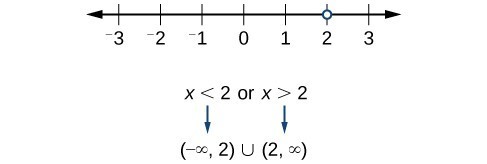Learning Outcomes
- Find the domain of a function defined by an equation.
- Write the domain and range using standard notations.
- Find domain and range from a graph.
- Give domain and range of Toolkit Functions.
- Graph piecewise-defined functions.
If you’re in the mood for a scary movie, you may want to check out one of the five most popular horror movies of all time—I am Legend, Hannibal, The Ring, The Grudge, and The Conjuring. Figure 1 shows the amount, in dollars, each of those movies grossed when they were released as well as the ticket sales for horror movies in general by year. Notice that we can use the data to create a function of the amount each movie earned or the total ticket sales for all horror movies by year. In creating various functions using the data, we can identify different independent and dependent variables, and we can analyze the data and the functions to determine the domain and range. In this section we will investigate methods for determining the domain and range of functions such as these.

Figure 1. Based on data compiled by www.the-numbers.com.
Standard Notation for Defining Sets
There are several ways to define sets of numbers or mathematical objects. The reason we are introducing this here is because we often need to define the sets of numbers that make up the inputs and outputs of a function.
How we write sets that make up the domain and range of functions often depends on how the relation or function are defined or presented to us. For example, we can use lists to describe the domain of functions that are given as sets of ordered pairs. If we are given an equation or graph, we might use inequalities or intervals to describe domain and range.
In this section, we will introduce the standard notation used to define sets, and give you a chance to practice writing sets in three ways, inequality notation, set-builder notation, and interval notation.
Consider the set [latex]\left\{x|10\le x<30\right\}[/latex], which describes the behavior of [latex]x[/latex] in set-builder notation. The braces [latex]\{\}[/latex] are read as “the set of,” and the vertical bar [latex]|[/latex] is read as “such that,” so we would read [latex]\left\{x|10\le x<30\right\}[/latex] as “the set of x-values such that 10 is less than or equal to [latex]x[/latex], and [latex]x[/latex] is less than 30.”
The table below compares inequality notation, set-builder notation, and interval notation.
To combine two intervals using inequality notation or set-builder notation, we use the word “or.” As we saw in earlier examples, we use the union symbol, [latex]\cup[/latex], to combine two unconnected intervals. For example, the union of the sets [latex]\left\{2,3,5\right\}[/latex] and [latex]\left\{4,6\right\}[/latex] is the set [latex]\left\{2,3,4,5,6\right\}[/latex]. It is the set of all elements that belong to one or the other (or both) of the original two sets. For sets with a finite number of elements like these, the elements do not have to be listed in ascending order of numerical value. If the original two sets have some elements in common, those elements should be listed only once in the union set. For sets of real numbers on intervals, another example of a union is
[latex]\left\{x|\text{ }|x|\ge 3\right\}=\left(-\infty ,-3\right]\cup \left[3,\infty \right)[/latex]
This video describes how to use interval notation to describe a set.
This video describes how to use Set-Builder notation to describe a set.
A General Note: Set-Builder Notation and Interval Notation
Set-builder notation is a method of specifying a set of elements that satisfy a certain condition. It takes the form [latex]\left\{x|\text{statement about }x\right\}[/latex] which is read as, “the set of all [latex]x[/latex] such that the statement about [latex]x[/latex] is true.” For example,
[latex]\left\{x|4 Interval notation is a way of describing sets that include all real numbers between a lower limit that may or may not be included and an upper limit that may or may not be included. The endpoint values are listed between brackets or parentheses. A square bracket indicates inclusion in the set, and a parenthesis indicates exclusion from the set. For example, [latex]\left(4,12\right][/latex]
How To: Given a line graph, describe the set of values using interval notation.
- Identify the intervals to be included in the set by determining where the heavy line overlays the real line.
- At the left end of each interval, use [ with each end value to be included in the set (solid dot) or ( for each excluded end value (open dot).
- At the right end of each interval, use ] with each end value to be included in the set (filled dot) or ) for each excluded end value (open dot).
- Use the union symbol [latex]\cup[/latex] to combine all intervals into one set.
Example: Describing Sets on the Real-Number Line
Describe the intervals of values shown below using inequality notation, set-builder notation, and interval notation.

Try It
Given the graph below, specify the graphed set in
- words
- set-builder notation
- interval notation

The table below gives a summary of interval notation.

Write Domain and Range Given an Equation
In Functions and Function Notation, we were introduced to the concepts of domain and range. In this section we will practice determining domains and ranges for specific functions. Keep in mind that, in determining domains and ranges, we need to consider what is physically possible or meaningful in real-world examples, such as tickets sales and year in the horror movie example above. We also need to consider what is mathematically permitted. For example, we cannot include any input value that leads us to take an even root of a negative number if the domain and range consist of real numbers. Or in a function expressed as a formula, we cannot include any input value in the domain that would lead us to divide by 0.
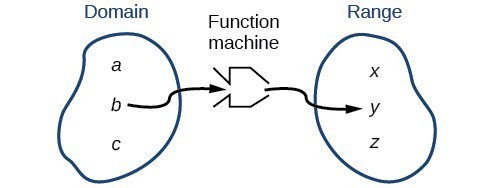
We can visualize the domain as a “holding area” that contains “raw materials” for a “function machine” and the range as another “holding area” for the machine’s products.
We can write the domain and range in interval notation, which uses values within brackets to describe a set of numbers. In interval notation, we use a square bracket [ when the set includes the endpoint and a parenthesis ( to indicate that the endpoint is either not included or the interval is unbounded. For example, if a person has $100 to spend, he or she would need to express the interval that is more than 0 and less than or equal to 100 and write [latex]\left(0,\text{ }100\right][/latex]. We will discuss interval notation in greater detail later.
Let’s turn our attention to finding the domain of a function whose equation is provided. Oftentimes, finding the domain of such functions involves remembering three different forms. First, if the function has no denominator or an even root, consider whether the domain could be all real numbers. Second, if there is a denominator in the function’s equation, exclude values in the domain that force the denominator to be zero. Third, if there is an even root, consider excluding values that would make the radicand negative.
Before we begin, let us review the conventions of interval notation:
- The smallest term from the interval is written first.
- The largest term in the interval is written second, following a comma.
- Parentheses, ( or ), are used to signify that an endpoint is not included, called exclusive.
- Brackets, [ or ], are used to indicate that an endpoint is included, called inclusive.
Example: Finding the Domain of a Function as a Set of Ordered Pairs
Find the domain of the following function: [latex]\left\{\left(2,\text{ }10\right),\left(3,\text{ }10\right),\left(4,\text{ }20\right),\left(5,\text{ }30\right),\left(6,\text{ }40\right)\right\}[/latex] .
Try It
Find the domain of the function:
[latex]\left\{\left(-5,4\right),\left(0,0\right),\left(5,-4\right),\left(10,-8\right),\left(15,-12\right)\right\}[/latex]
How To: Given a function written in equation form, find the domain.
- Identify the input values.
- Identify any restrictions on the input and exclude those values from the domain.
- Write the domain in interval form, if possible.
Example: Finding the Domain of a Function
Find the domain of the function [latex]f\left(x\right)={x}^{2}-1[/latex].
Try It
Find the domain of the function: [latex]f\left(x\right)=5-x+{x}^{3}[/latex].
How To: Given a function written in an equation form that includes a fraction, find the domain.
- Identify the input values.
- Identify any restrictions on the input. If there is a denominator in the function’s formula, set the denominator equal to zero and solve for [latex]x[/latex] . These are the values that cannot be inputs in the function.
- Write the domain in interval form, making sure to exclude any restricted values from the domain.
Example: Finding the Domain of a Function Involving a Denominator (Rational Function)
Find the domain of the function [latex]f\left(x\right)=\dfrac{x+1}{2-x}[/latex].
Try It
Find the domain of the function: [latex]f\left(x\right)=\dfrac{1+4x}{2x - 1}[/latex].
How To: Given a function written in equation form including an even root, find the domain.
- Identify the input values.
- Since there is an even root, exclude any real numbers that result in a negative number in the radicand. Set the radicand greater than or equal to zero and solve for [latex]x[/latex].
- The solution(s) are the domain of the function. If possible, write the answer in interval form.
Example: Finding the Domain of a Function with an Even Root
Find the domain of the function [latex]f\left(x\right)=\sqrt{7-x}[/latex].
Try It
Find the domain of the function [latex]f\left(x\right)=\sqrt{5+2x}[/latex].
Q & A
Can there be functions in which the domain and range do not intersect at all?
Yes. For example, the function [latex]f\left(x\right)=-\frac{1}{\sqrt{x}}[/latex] has the set of all positive real numbers as its domain but the set of all negative real numbers as its range. As a more extreme example, a function’s inputs and outputs can be completely different categories (for example, names of weekdays as inputs and numbers as outputs, as on an attendance chart), in such cases the domain and range have no elements in common.
TRY IT
When you are defining the domain of a function, it can help to graph it, especially when you have a rational or a function with an even root.
First, determine the domain restrictions for the following functions, then graph each one to check whether your domain agrees with the graph.
- [latex]f(x) = \sqrt{2x-4}+5[/latex]
- [latex]g(x) = \dfrac{2x+4}{x-1}[/latex]
Next, use an online graphing tool to evaluate your function at the domain restriction you found. What function value does a graphing calculator give you?
How To: Given the formula for a function, determine the domain and range.
- Exclude from the domain any input values that result in division by zero.
- Exclude from the domain any input values that have nonreal (or undefined) number outputs.
- Use the valid input values to determine the range of the output values.
- Look at the function graph and table values to confirm the actual function behavior.
Example: Finding the Domain and Range Using Toolkit Functions
Find the domain and range of [latex]f\left(x\right)=2{x}^{3}-x[/latex].
Example: Finding the Domain and Range
Find the domain and range of [latex]f\left(x\right)=\dfrac{2}{x+1}[/latex].
Example: Finding the Domain and Range
Find the domain and range of [latex]f\left(x\right)=2\sqrt{x+4}[/latex].
Try It
Find the domain and range of [latex]f\left(x\right)=-\sqrt{2-x}[/latex].
Determine Domain and Range from a Graph
Another way to identify the domain and range of functions is by using graphs. Because the domain refers to the set of possible input values, the domain of a graph consists of all the input values shown on the [latex]x[/latex]-axis. The range is the set of possible output values, which are shown on the [latex]y[/latex]-axis. Keep in mind that if the graph continues beyond the portion of the graph we can see, the domain and range may be greater than the visible values.
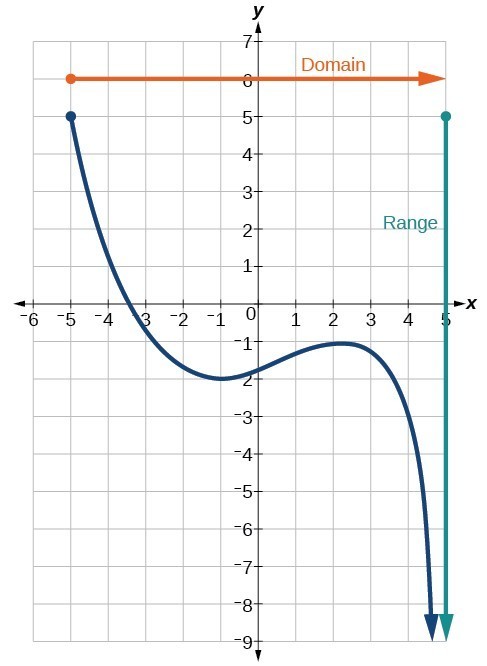
We can observe that the graph extends horizontally from [latex]-5[/latex] to the right without bound, so the domain is [latex]\left[-5,\infty \right)[/latex]. The vertical extent of the graph is all range values [latex]5[/latex] and below, so the range is [latex]\left(\mathrm{-\infty },5\right][/latex]. Note that the domain and range are always written from smaller to larger values, or from left to right for domain, and from the bottom of the graph to the top of the graph for range.
Example: Finding Domain and Range from a Graph
Find the domain and range of the function [latex]f[/latex].
![Graph of a function from (-3, 1].](https://s3-us-west-2.amazonaws.com/courses-images/wp-content/uploads/sites/896/2016/10/18193551/CNX_Precalc_Figure_01_02_0072.jpg)
Example: Finding Domain and Range from a Graph of Oil Production
Find the domain and range of the function [latex]f[/latex].

(credit: modification of work by the U.S. Energy Information Administration)
Try It
Given the graph, identify the domain and range using interval notation.

Q & A
Can a function’s domain and range be the same?
Yes. For example, the domain and range of the cube root function are both the set of all real numbers.
Domain and Range of Toolkit Functions
We will now return to our set of toolkit functions to determine the domain and range of each.

For the constant function [latex]f\left(x\right)=c[/latex], the domain consists of all real numbers; there are no restrictions on the input. The only output value is the constant [latex]c[/latex], so the range is the set [latex]\left\{c\right\}[/latex] that contains this single element. In interval notation, this is written as [latex]\left[c,c\right][/latex], the interval that both begins and ends with [latex]c[/latex].
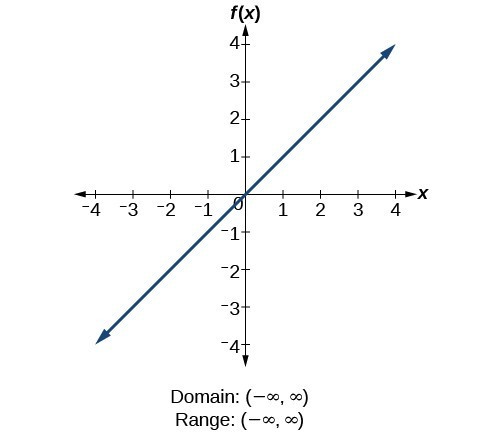
For the identity function [latex]f\left(x\right)=x[/latex], there is no restriction on [latex]x[/latex]. Both the domain and range are the set of all real numbers.
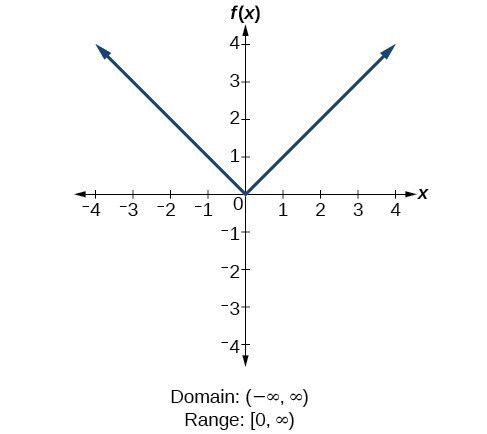
For the absolute value function [latex]f\left(x\right)=|x|[/latex], there is no restriction on [latex]x[/latex]. However, because absolute value is defined as a distance from 0, the output can only be greater than or equal to 0.
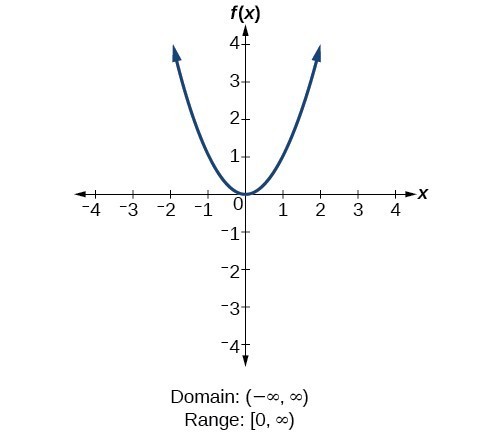
For the quadratic function [latex]f\left(x\right)={x}^{2}[/latex], the domain is all real numbers since the horizontal extent of the graph is the whole real number line. Because the graph does not include any negative values for the range, the range is only nonnegative real numbers.
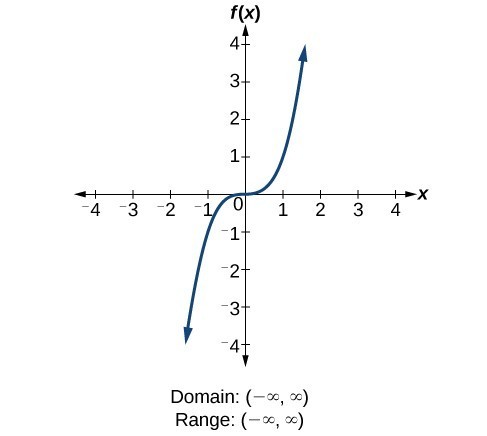
For the cubic function [latex]f\left(x\right)={x}^{3}[/latex], the domain is all real numbers because the horizontal extent of the graph is the whole real number line. The same applies to the vertical extent of the graph, so the domain and range include all real numbers.
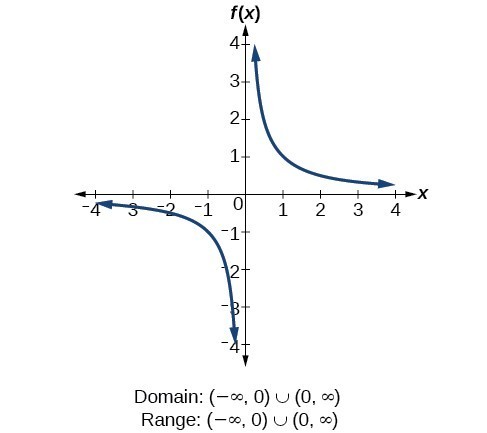
For the reciprocal function [latex]f\left(x\right)=\frac{1}{x}[/latex], we cannot divide by 0, so we must exclude 0 from the domain. Further, 1 divided by any value can never be 0, so the range also will not include 0. In set-builder notation, we could also write [latex]\left\{x|\text{ }x\ne 0\right\}[/latex], the set of all real numbers that are not zero.
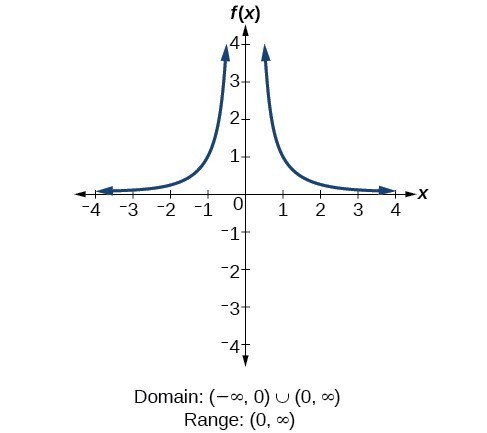
For the reciprocal squared function [latex]f\left(x\right)=\frac{1}{{x}^{2}}[/latex], we cannot divide by [latex]0[/latex], so we must exclude [latex]0[/latex] from the domain. There is also no [latex]x[/latex] that can give an output of 0, so 0 is excluded from the range as well. Note that the output of this function is always positive due to the square in the denominator, so the range includes only positive numbers.
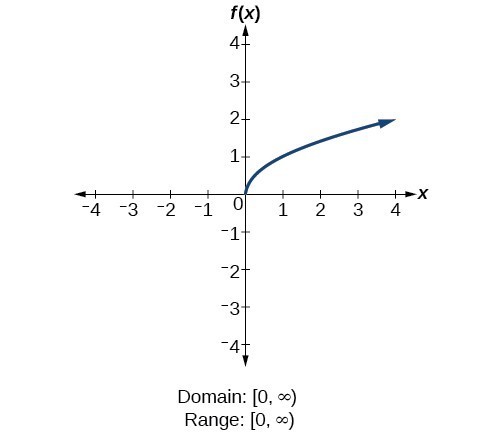
For the square root function [latex]f\left(x\right)=\sqrt[]{x}[/latex], we cannot take the square root of a negative real number, so the domain must be 0 or greater. The range also excludes negative numbers because the square root of a positive number [latex]x[/latex] is defined to be positive, even though the square of the negative number [latex]-\sqrt{x}[/latex] also gives us [latex]x[/latex].
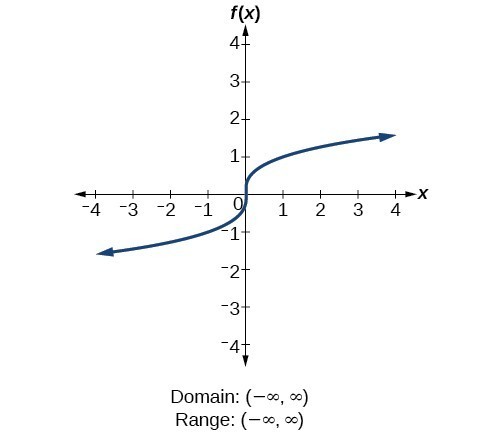
For the cube root function [latex]f\left(x\right)=\sqrt[3]{x}[/latex], the domain and range include all real numbers. Note that there is no problem taking a cube root, or any odd-integer root, of a negative number, and the resulting output is negative (it is an odd function).
Try It
Key Concepts
- The domain of a function includes all real input values that would not cause us to attempt an undefined mathematical operation, such as dividing by zero or taking the square root of a negative number.
- The domain of a function can be determined by listing the input values of a set of ordered pairs.
- The domain of a function can also be determined by identifying the input values of a function written as an equation.
- Interval values represented on a number line can be described using inequality notation, set-builder notation, and interval notation.
- For many functions, the domain and range can be determined from a graph.
- An understanding of toolkit functions can be used to find the domain and range of related functions.
Glossary
- interval notation
- a method of describing a set that includes all numbers between a lower limit and an upper limit; the lower and upper values are listed between brackets or parentheses, a square bracket indicating inclusion in the set, and a parenthesis indicating exclusion
- set-builder notation
- a method of describing a set by a rule that all of its members obey; it takes the form [latex]\left\{x|\text{statement about }x\right\}[/latex]
Candela Citations
- Revision and Adaptation. Provided by: Lumen Learning. License: CC BY: Attribution
- Question ID 60533, 61836, 47487, 11812. Authored by: Lumen Learning. License: CC BY: Attribution. License Terms: IMathAS Community License CC-BY + GPL
- College Algebra. Authored by: Abramson, Jay et al.. Provided by: OpenStax. Located at: http://cnx.org/contents/9b08c294-057f-4201-9f48-5d6ad992740d@5.2. License: CC BY: Attribution. License Terms: Download for free at http://cnx.org/contents/9b08c294-057f-4201-9f48-5d6ad992740d@5.2
- Question ID 108347. Authored by: Coulston, Charles R. License: CC BY: Attribution. License Terms: IMathAS Community License CC-BY + GPL
- Question ID 3190, 3191. Authored by: Anderson, Tophe. License: CC BY: Attribution. License Terms: IMathAS Community License CC-BY + GPL
- Question ID 72181. Authored by: Carmichael, Patrick. License: CC BY: Attribution. License Terms: IMathAS Community License CC-BY + GPL
- Question ID 30831, 32883. Authored by: Smart, Jim. License: CC BY: Attribution. License Terms: IMathAS Community License CC-BY + GPL
- Question ID 92940, 3765, 93008. Authored by: Jenck, Michael. License: CC BY: Attribution. License Terms: IMathAS Community License CC-BY + GPL
- Question ID 47481, 47483, 47484. Authored by: Day, Alyson. License: CC BY: Attribution. License Terms: IMathAS Community License CC-BY + GPL
- Question ID 1657. Authored by: WebWork-Rochester, mb Sousa,James. License: CC BY: Attribution. License Terms: IMathAS Community License CC-BY + GPL
- Finding Function Values. Authored by: Mathispower4u. Located at: https://youtu.be/NTmgEF_nZSc. License: All Rights Reserved. License Terms: Standard YouTube License
- Ex: Evaluate a Function and Solve for a Function Value Given a Table. Authored by: Mathispower4u. Provided by: Phoenix College. Located at: https://youtu.be/meqZdQkoNOQ. License: All Rights Reserved. License Terms: Standard YouTube License
- Ex1: Evaluate a Function and Solve for a Function Value Given a Graph. Authored by: Mathispower4u. Provided by: Phoenix College. Located at: https://www.youtube.com/watch?v=_fO9gx1ncyg.. License: All Rights Reserved. License Terms: Standard YouTube License
- Find Function Inputs for a Given Quadratic Function Output. Authored by: James Sousa. Located at: https://youtu.be/GLOmTED1UwA. License: All Rights Reserved. License Terms: Standard YouTube License
- Write a Linear Relation as a Function. Authored by: James Sousa. Located at: https://www.youtube.com/watch?v=lHTLjfPpFyQ&feature=youtu.be. License: All Rights Reserved. License Terms: Standard YouTube License






